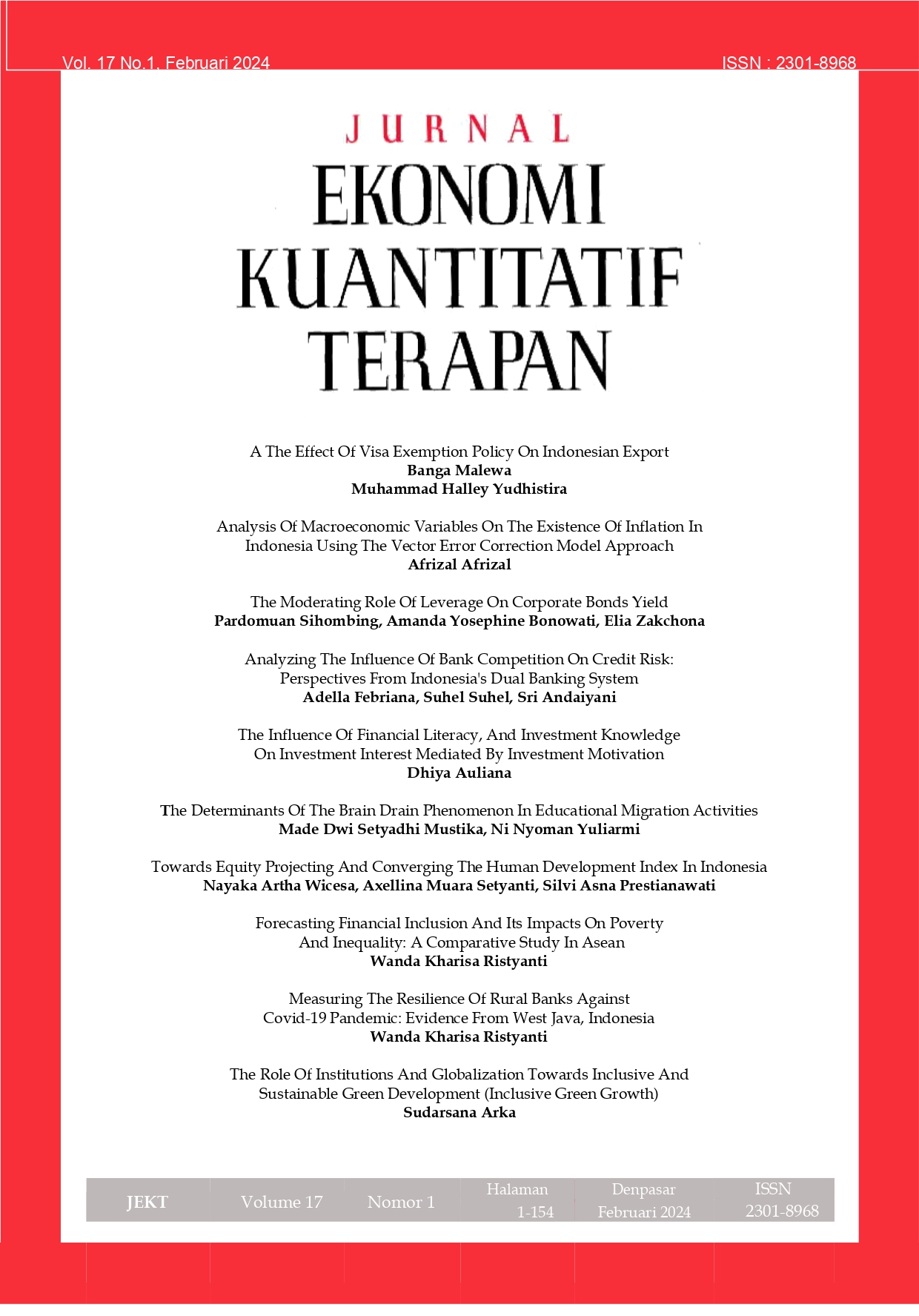Analyzing the Influence of Bank Competition on Credit Risk: Perspectives from Indonesia's Dual Banking System
Abstract
This study analyzes the effect of competition banks on credit risk in the dual banking system in Indonesia. This research was conducted using a purposive sampling technique in selecting a sample of 5 conventional commercial banks and 5 Islamic commercial banks. The method used is the Generalized Method of Moments (GMM) from 2011 to 2020. Credit risk for Conventional Banks is measured by the value of Non-Performing Loan (NPL), while Islamic Bank Financing is measured by the value of Non-Performing Financing (NPF). The results of this study indicate that Return on Assets (ROA) for Conventional Banks and Islamic Banks has a significant effect on credit risk in the dual banking system, Loan to Deposit Ratio (LDR) for Conventional Banks does not have a significant effect on Non-Performing Loan (NPL) while Financing to Deposit Ratio (FDR) of Islamic Banks has a significant level 2 influence on Non-Performing Financing (NPF). Bank size does not have a significant influence on credit risk in the dual banking system, and the Lerner Index for Conventional Banks has a significant effect on Non-Performing Loan (NPL), while the Lerner Index for Islamic Banks has no effect on Non-Performing Financing (NPF). The Central Bank in making policies can see that the level of competition for banks in the dual banking system in Indonesia is categorized as a monopolistic competition market, where each bank has its own market segment so that it has market power that is strong enough to set prices that are relatively.
Downloads
References
Brei, M., (2020). Credit Risk and Bank Competition in Sub-Saharan Africa. Emerging Markets Review, 44(July), 100716. https://doi.org/10.1016/j.ememar.2020.100716
Castro, V. (2018). Macroeconomic and bank-spesific determinants of the credit risk in the banking system: The case of GIPSI. Journal Economic Modelling 31, 672-683
Catherine, N. (2020). Credit Risk Management and Financial Performance: A Case of Bank of Africa (U) Limited. Open Journal of Business and Management, 08(01), 30–38. https://doi.org/10.4236/ojbm.2020.81002
Chen, S., Zhang, Y., & Li, L. (2022). A Comparative Study of Credit Risk Infection at Domestic and Abroad Based on Knowledge Map. Procedia Computer Science, 199, 215–222. https://doi.org/10.1016/j.procs.2022.01.027
Cheng, N., & Bang, Y. (2021). A Comment on The Practice of The Arellano-Bond/Blundell-Bond Generalized Method of Moments Estimator in Research. Communications of the Association for Information Systems, 48, 423–442. https://doi.org/10.17705/1cais.04838
Demirguc-Kunt, A. (2020). A Framwork for Analyzing Competition in The Banking Sector. Poliy Research Working Paper, 21(1), 1–12.
Duffie, & Singleton, K. (2015). Modeling the Term Structure of Defaul table Bonds, Review of Financial Studies. The Review of Financial Studies, 12. https://doi.org/https://doi.org/10.1093/rfs/12.4.687
Hao, X., Sun, Q., & Xie, F. (2022). The COVID-19 pandemic, consumption and sovereign credit risk: Cross-country evidence. Economic Modelling, 109(February), 105794. https://doi.org/10.1016/j.econmod.2022.105794
Isnaini, F., Sahara, S., & Nursyamsiah, T. (2021). Faktor-faktor yang Memengaruhi Tingkat Non Performing Financing dan Non Performing Loan pada Dual Banking System di Indonesia. Al-Muzara’ah, 7(1), 47–59. https://doi.org/10.29244/jam.7.1.47-59
Isnaini, L, & Muhdir, I. (2021). Pengaruh ROA, CAR, BOPO, FDR, Dan Inflasi Terhadap Pembiayaan Bermasalah (NPF) Di Bank Umum Syariah. JPEK (Jurnal Pendidikan Ekonomi Dan Kewirausahaan), 5(1), 65–75. https://doi.org/10.29408/jpek.v5i1.3095
Km. Suli Astrini, I Wayan Suwendra. (2018). Pengaruh CAR, LDR, dan Bank Size Terhadap NPL Pada Lembaga Perbankan Yang Terdaftar di Bursa Efek Indonesia. 9.
Kusuma, & Haryanto. (2021). Analisis pengaruh variabel kinerja bank (CAR, ROA, BOPO, dan LDR), serta pertumbuhan kredit dan kualitas kredit terhadap Non Performing Loan (NPL). Diponegoro Journal of Management, 5(2015), 1–13.
Laksono & Setyawan, I. R. (2019). Faktor Penentu Non Performing Loan Pada Bank Umum Konvensional Di Indonesia. Jurnal Manajerial Dan Kewirausahaan, 1(3), 506. https://doi.org/10.24912/jmk.v1i3.5362.
Louis D.P., Vouldis A.T., & Metaxas V.L. (2019). Macroeconomic and bank-spesific determinants of non-performing loans in Greece: A comparative study of mortgage, business and consumer loan portofolios. Journal of Banking & Finance 36,1012-1027.
Martinez, & Repullo, R. (2010). Does competition reduce the risk of bank failure. Review Financial Studies 23(10), 3638–3664.
Munandar, A. (2022). Faktor – Faktor Yang Memengaruhi Financing To Deposit Ratio ( FDR ) Terhadap Return on Assets ( ROA ) Dan Net Operating Margin ( NOM ) Pada Bank Umum Syariah Periode. Universitas Indo Global Mandiri, 7, 1–12.
Ozdaglar, A. (2020). Systemic Risk and Stability in Financial Networks. American Economic Review, 2, 105. https://doi.org/ 10.1108/ijoem-01-2020-0035
Prasetyo, A. (2017). Pengaruh Risiko Kredit, Likuiditas, Kecukupan Modal, Dan Efisiensi Operasional Terhadap Profitabilitas Pada PT. BPD Bali. E-Jurnal Manajemen Unud, 4(9), 2590–2617. https://doi.org/ 10.1108/ijoem-01-2020-0035
Pratiwi, & Masdupi, E. (2021). Effect of Credit Risk, Market Risk and Liquidity Risk on Return on Assets of Conventional Commercial Banks Registered in The Financial Services Authority During the COVID-19 Pandemic. Financial Management Studies, 4(29), 29–46. https://doi.org/ 10.1108/ijoem-01-2020-0035
Loffler, G & Posch. (2019). Credit Risk Modeling using excel and vba. Journal of Banking and Finance. 90 (1), 147 - 165
Rai, N., & Thapa, B. (2015). a Study on Purposive Sampling Method in Research. Kathmandu: Kathmandu School of Law, 1–12.
Roski, D. (2019). Dual Banking System di Indonesia dalam Perspektif Politik Hukum Ekonomi Syari’ah Mukhlisha Dina Roski. Jurnal Studi Islam, 2 no., 61–73.
Saadaoui & Hamza, H. (2020). Lending cyclicality in dual banking system: empirical evidence from GCC countries. Journal of Islamic Accounting and Business Research, 11(9), 2113–2135. https://doi.org/10.1108/-03-2020-0082
Scott, (2019). Competition and financial stability. Journal of Money Credit and Banking, 453–480. https://doi.org/10.12695/jmt.2018.17.3.1
Seho, (2021). Does sectoral diversification of loans and financing improve bank returns and risk in dual-banking systems? Pacific Basin Finance Journal, 68(July). https://doi.org/10.1016/j.pacfin.2021.101619
Tan, Y. (2020). The Impact of Risk and Competition on Bank Profitability in China. Journal of Internasional Financial Market, Institution and Money 5(1), 90–106.
Tawfik & Osman (2020). Banking Crises in the Dual Banking System in Indonesia: The markov Switching Approach. JKAU: Islamic Econ, 33(1), 101–116. https://doi.org/10.4197/Islec
Valaskova, K. (2014). Assessing Credit Risk by Merton Model. International Conference on Management, Education, Business, and Information Science (Icmebis 2014), February, 27–30.
Wheelock & Wilson, P. (2020). New estimates of the Lerner index of market power for US banks. Unpublishe January.




















